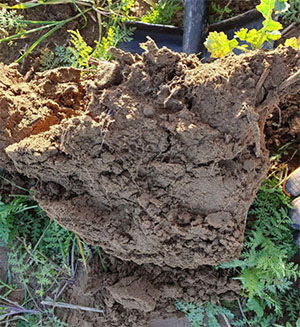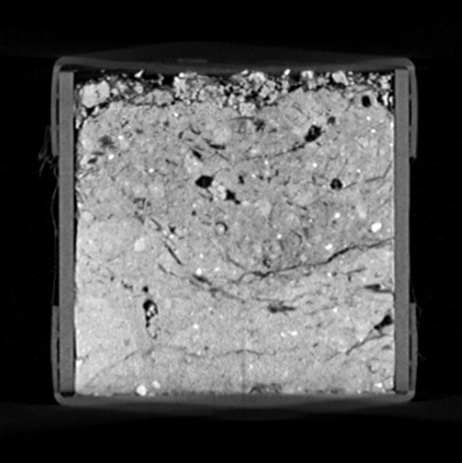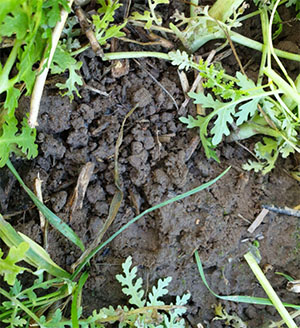Dr Joschko, you have been researching soil since 1986. Why are you doing this work?
My grandfather was a farmer, my father a doctor. I combine both professions in my work and investigate soil samples with the help of computer tomography (CT). In the same way that we perform CT scans on people to find out what is wrong with them, it is really quite logical that the best way to analyse soil is to take a good look inside it. The soil structure is extremely important in agricultural practice.
What exactly is the soil structure?

Soil structure is the spatial arrangement of the solid components – organic and mineral – and the hollow spaces between them. This varies between different soils and provides indications of fertility and health because quality can be gauged by the grain size, aggregation, pore distribution, distribution of plant remains, humus content, rooting, and the diversity of soil organisms.
The fertility and health of the soil is indicated by its structure.
Dr Monika Joschko
How do you look inside the soil?
A team of researchers has been taking soil samples from nine locations in Germany and a further 12 countries in Europe since 2015 for the DIWELA* project. We then examined the samples with a CT, whereby we virtually cut them into ‘slices’. It was important that the samples were undisturbed to ensure reliable results. In other words, they needed to retain the exact layer and structure as they had underground. We used a ‘soil column’ to achieve this in the samples.
That sounds like a lot of work!
But it’s really not. We have even developed a method that enables farmers across Europe to take these field samples. But, of course, we had to make sure that the samples weren’t shaken or disturbed in any other way during delivery. It would have been better if the samples could have been examined directly in the countries.
Do you work together with farmers?
Yes, of course. Our partners are farmers. For example, the Komturei Lietzen in Brandenburg with 1,100ha. We have been working with them since 1996. At this site, we compare sandy soil with conventional, low disturbance and no-till operations at different locations. It’s best to take the sample after harvest, as that is generally when the soil has not been worked for a long time. The findings were clear. Under lower tillage operations, we found a good crumb structure and numerous earthworm tunnels, but this was not the case in inverted tillage set-ups. The investigations of clay soil in Oderbruch were also surprising. We took samples from suspected, compacted soil, from driving tracks, and compared them with less-compacted soil from the fields. Despite the loads, the soil structure was fully intact. There can be many reasons for this. In this case it was due to clay soil and many years of min-till using disk harrows.
Field trial in Lietzen: Long-term ploughing, soil sample from a depth of 0-12 cm shows a few earthworm tunnels, some of which run parallel to each other.
Many years of reduced, non-turning tillage. Dense network of numerous small and large earthworm tunnels. More biopores are visible.
Compacted soil without earthworm tunnels at the headland in front of a limestone deposit. The pore system is compressed and the soil structure is destroyed.
How can farmers affect the soil structure?
Farmers and growers cannot actually change the grain size and climate in their region. However, they can support the natural processes in the soil. The type of farming plays a major role in soil structure. The selection and sequence of crops and catch crops, as well as the mechanical tillage have an influence.
No-till farming is good for the soil structure
Dr. Monika Joschko
No-till farming, for example, provides a good opportunity to vary tillage practice, perhaps, working only a third of the soil per season. In the interim period, earthworms and other organisms move around, which is good for soil structure. Farmers can also save costs with no-till farming while achieving the same or even greater yields.
What was the result of the DIWELA* research project?
The results of our analyses can help optimise farm management if farmers take a more focused approach to soil structure. We have created a “structure atlas” of the management options for different soil types; the results form a good foundation for further research.
Plot 1

Soil sample
Field structure analysis (FGA), a field structure assessment method, was carried out on reduced tillage plots in parallel with X-ray CT.
X-ray CT slice image

Result
Plot with 4 % clay
Maximum earthworm population
24 animals/m²
Earthworm burrows in CT : Score 1
Plot 2

Hole
Six structural indicators are assessed: Soil surface, root penetration, macro/biopores, consolidation, organic residues, colour and odour.
X-ray CT slice image

Result
Plot with 6% clay
Maximum earthworm population
96 animals/m²
Earthworm burrows in CT: Score 2
Plot 3

Soil surface
There was good match between CT and FGA, particularly regarding biopores resulting from earthworm activity.
X-ray CT slice image

Result
Plot with 10 % clay
Maximum earthworm population
124 animals/m²
Earthworm burrows in CT : Score 5
Conclusion: The CT sopil structure is a good indicator for earthworm population.
What is your advice for farmers and contractors?
The better farmers know their soil, the more efficiently they can farm it. No-till farming, for example, does not prove advantageous everywhere – but it does in some regions. So, for example, sandy soils without a defined soil structure are not suitable for no-till farming, because they tend towards denser stratification over the years.
With heavier soils that can be very dry or wet during seeding, the influence of the technical systems used, fluctuates heavily, so that yield stability often cannot be achieved. Soils in dry regions often lack moisture for active soil organisms. It is important to work soil as little as possible and keep it covered with catch crops or organic matter from the preceding crop. In this way, it can handle heat and heavy rain more easily and soil organisms can develop.
DIWELA project
(German: Entwicklung eines Diagnosewerkzeugs für die Landwirte; English: development of a diagnostics tool for farmers, serving to increase soil fertility). Led by ZALF e.V. and agrathaer, sponsored by Landwirtschaftliche Rentenbank. Systematic soil investigations have been carried out on soils farmed in different ways in long-term field tests and practical operations since 2015. The hypothesis is that soil structure varies greatly, depending on how the soil is treated. The aim of the work is to develop a diagnostic tool for farmers to record condition of the soil structure. It will allow the effect of different farming processes on structural damage, to be visualised and quantified.
Partners
Leibniz-Institut für Zoo- und Wildtierforschung (IZW), Berlin


